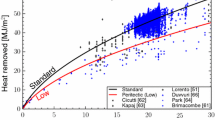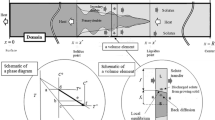Abstract
A thermo-elasto-plastic analysis is performed to study the effect of mushy zone thickness on residual stress formation in alloy solidification. Specific heat flux distributions on the model boundaries are predicted in order to achieve pre-defined mushy zone thicknesses. The effective heat capacity method is utilized for the thermal analysis of the solidification process. The von-Mises criterion with a hardening model and stress–strain power law is employed to describe the elasto-plastic behavior. Material parameters are assumed to be temperature dependent and required analyses are made using the meshless local Petrov–Galerkin method. Several numerical examples are presented to calculate the temperature and stress fields developed in the material undergoing solidification. Under the assumed conditions, we conclude that the mushy zone thickness does not play a significant role in the development of residual stresses in the cast material. Moreover, it is shown that the solidification time can be reduced without having a significant effect on the residual stresses.























Similar content being viewed by others
References
Dantzig JA, Rappaz M (2009) Solidification. EPFL Press, Switzerland
Bellet M, Thomas BG (2008) Modeling of stress, distortion, and hot tearing. In: ASM Handbook, Cast., ASM International, 15: 449–461
Tszeng TC, Kobayashi S (1989) Stress analysis in solidification processes: application to continuous casting. Int J Mach Tools Manufact 29:121–140
Flemings MC (1974) Solidification processing. McGraw Hill, New York
Donachie MJ, Donachie SJ (2002) Superalloys: a technical guide. ASM International, Ohio
Nejad AA, Maghrebi MJ, Tabrizi HB et al (2010) Optimal operation of alloy material in solidification processes with inverse heat transfer. Int Commun Heat Mass 37(6):711–716
Tien R, Kaump V (1969) Thermal stresses during solidification on basis of elastic model. J Appl Mech 36:763–767
Weiner JH, Boley BA (1963) Elasto-plastic thermal stresses in a solidifying body. J Mech Phys Solids 11:145–154
Cross M (1992) Control volume model of fluid flow, solidification and stress. Thames Polytechnic, London
Williams JR, Lewis RW, Morgan K (1979) An elasto–viscoplastic thermal stress model with applications to the continuous casting of metals. Int J Num Meth Eng 14:1–9
Kristiansson JO (1984) Thermomechanical behavior of the solidifying shell within continuous casting billet molds: a numerical approach. J Therm Stresses 7:209–226
Heinlein M, Mukherjee S, Richmond O (1986) A boundary element method analysis of temperature fields and stresses during solidification. Acta Mech 59:59–81
Zabaras N, Ruan Y, Richmond O (1990) Front tracking thermomechanical model for hypoelastic–viscoplastic behavior in a solidifying body. Comt Meth Appl Mech Eng 81:333–364
Zabaras N, Ruan Y, Richmond O (1991) On the calculation of deformations and stresses during axially symmetric solidification. J Appl Mech 58:865–871
Park JK, Thomas BG, Samarasekera IV (2002) Analysis of thermomechanical behaviour in billet casting with different mould corner radii. Ironmak Steelmak 29:359–375
Li C, Thomas BG (2004) Thermomechanical finite-element model of shell behavior in continuous casting of steel. Metall Mater Trans B 35:1151–1172
Mariano PM (2004) Some thermodynamical aspects of the solidification of two-phase flows. Meccanica 39(4):369–382
Tan L, Zabaras N (2005) A thermomechanical study of the effects of mold topography on the solidification of aluminum alloys. Mater Sci Eng A 404(1):197–207
Samanta D, Zabaras N (2005) A coupled thermomechanical, thermal transport and segregation analysis of the solidification of aluminum alloys on molds of uneven topographies. Mater Sci Eng A 408(1):211–216
Koric S, Thomas BG (2006) Efficient thermo-mechanical model for solidification processes. Int J Numer Meth Eng 66(12):1955–1989
Koric S, Hibbeler LC, Thomas BG (2009) Explicit coupled thermo-mechanical finite element model of steel solidification. Int J Numer Meth Eng 78(1):1–31
Koric S, Thomas BG, Voller VR (2010) Enhanced latent heat method to incorporate superheat effects into fixed-grid multiphysics simulations. Numer Heat Tr B-Fund 57(6):396–413
Koric S, Hibbeler LC, Liu R, Thomas BG (2010) Multiphysics model of metal solidification on the continuum level. Numer Heat Tr B-Fund 58(6):371–392
Teskeredžić A, Demirdžić I, Muzaferija S (2015) Numerical method for calculation of complete casting process—Part I: theory. Numer Heat Tr B 68:295–316
Teskeredžić A, Demirdžić I, Muzaferija S (2015) Numerical method for calculation of complete casting process—Part II: validation and application. Numer Heat Tr B 68:317–335
Balokhonov R, Romanova V, Batukhtina E et al (2016) A mesomechanical analysis of the stress–strain localisation in friction stir welds of polycrystalline aluminium alloys. Meccanica 51(2):319–328
Nayroles B, Touzot G, Villon P (1992) Generalizing the finite element method: diffuse approximation and diffuse elements. Comput Mech 10:307–318
Belytschko T, Lu YY, Gu L (1994) Element-free Galerkin methods. Int J Num Meth Eng 37:229–256
Liu WK, Jun S, Zhang Y (1995) Reproducing kernel particle methods. Int J Numer Methods Fluids 20:1081–1106
Duarte CA, Oden JT (1996) Hp-cloud–a meshless method to solve boundary-value problems. Comp Meth Appl Mech Eng 139:237–262
Babuska I, Melenk J (1997) The partition of unity method. Int J Num Meth Eng 40:727–758
Sajja UK, Felicelli SD (2009) Application of the meshless element-free Galerkin method to freckle formation in directional solidification. Proceedings of the ASME international mechanical engineering congress and exposition, Lake Buena Vista, Florida, USA, 13–19 Nov 2009, paper no. IMECE2009-11257, pp. 553–562. New York: ASME
Atluri SN, Shen S (2002) The meshless local Petrov–Galerkin (MLPG) method. Tech Science Press, USA
Khosravifard A, Hematiyan MR (2010) A new method for meshless integration in 2D and 3D Galerkin meshfree methods. Eng Anal Bound Elem 34(1):30–40
Hematiyan MR, Khosravifard A, Liu GR (2014) A background decomposition method for domain integration in weak-form meshfree methods. Comput Struct 142:64–78
Atluri SN, Zhu T (1998) A new meshless local Petrov–Galerkin (MLPG) approach in computational mechanics. Comput Mech 22:117–127
Atluri SN, Shen S (2002) The meshless local Petrov–Galerkin (MLPG) method: a simple and less–costly alternative to the finite element and boundary element methods. CMES: Comput Model Eng Sci 3(1):11–51
Zhang L, Shen HF, Rong YM et al (2007) Numerical simulation on solidification and thermal stress of continuous casting billet in mold based on meshless methods. Mater Sci Eng A 466:71–78
Lewis RW, Ravindran K (2000) Finite element simulation of metal casting. Int J Num Meth Eng 47:29–59
Voller VR, Swaminathan CR, Thomas BG (1990) Fixed grid techniques for phase change problems: a review. Int J Num Meth Eng 30:875–898
Nedjar B (2002) An enthalpy-based finite element method for nonlinear heat problems involving phase change. Comput Struct 80(1):9–21
Hsu TR (1986) The finite element methods in thermomechanics. Allen & Unwin, Massachusetts
Ludwik P (1909) Elemente der Technologischen Mechanik. Springer, Verlag Berlin Heidelberg
Thakur H, Singh KM, Sahoo PK (2011) Phase change problems using the MLPG method. Numer Heat Tr A-Appl 59(6):438–458
Reddy JN (1993) An introduction to the finite element method. McGraw-Hill, Singapore
Vaghefi R, Hematiyan MR, Nayebi A (2016) Three-dimensional thermo-elastoplastic analysis of thick functionally graded plates using the meshless local Petrov–Galerkin method. Eng Anal Bound Elem 71:34–49
Vaghefi R, Baradaran GH, Koohkan H (2010) Three-dimensional static analysis of thick functionally graded plates by using meshless local Petrov–Galerkin (MLPG) method. Eng Anal Bound Elem 34(6):564–573
Khosravifard A, Hematiyan MR, Wrobel LC (2013) Simultaneous control of solidus and liquidus lines in alloy solidification. Eng Anal Bound Elem 37:211–224
Nemat-Alla M, Ahmed KIE, Hassab-Allah I (2009) Elastic–plastic analysis of two dimensional functionally graded materials under thermal loading. Int J Solids Struct 46:2774–2786
Christman DR, Isbell WM, Babcock SG et al (1971) Measurements of dynamic properties of materials. 6061-T6 Aluminum, Defense Technical Information Center, vol 3, Washington, DC
Ludwig O, Drezet J-M, Martin C-L, Suery M (2005) Rheological behavior of Al-Cu alloys during solidification constitutive modeling, experimental identification, and numerical study. Met Mater Trans A 36:1525–1535
Koric S, Thomas BG (2008) Thermo-mechanical models of steel solidification based on two elastic visco-plastic constitutive laws. J Mater Process Technol 197(1):408–418
Kazemi Z, Hematiyan MR, Vaghefi R (2017) Meshfree radial point interpolation method for analysis of viscoplastic problems. Eng Anal Bound Elem 82:172–184
Author information
Authors and Affiliations
Corresponding author
Ethics declarations
Conflict of interest
The authors declare that they have no conflict of interest.
Rights and permissions
About this article
Cite this article
Vaghefi, R., Nayebi, A., Hematiyan, M.R. et al. Investigating the effects of mushy zone thickness on residual stresses in alloy solidification. Meccanica 53, 905–922 (2018). https://doi.org/10.1007/s11012-017-0742-x
Received:
Accepted:
Published:
Issue Date:
DOI: https://doi.org/10.1007/s11012-017-0742-x




